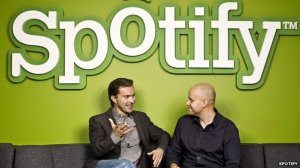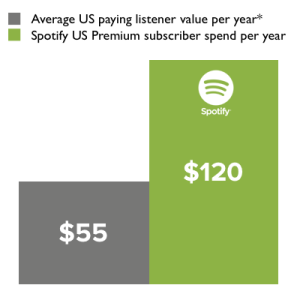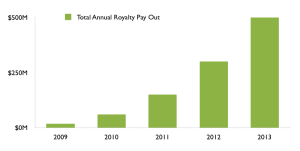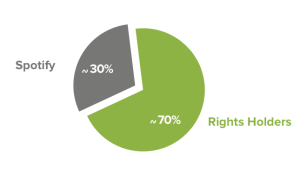
The music industry has waged a tricky battle in its fight against the ever-changing ways consumers obtain music. The music industry was once a dominant force in the entertainment world; at its peak in 1999, 943 million CD albums were sold. While the industry was at its peak, it was also on the verge of a slippery slope it wasn’t prepared for. In the same year, Napster made its debut, not only changing the way music was distributed but slashing the price to free. Napster took off in popularity gaining over 60 million users and dramatically changed consumers’ mindset on what the value of music was. As a legal response to illegal downloads, iTunes was created in 2003, but many believe that the four year lag was the industry’s fatal mistake.
iTunes created a digital music option for consumers, allowing the purchase of single tack for around $1 but, compared to free, $1 doesn’t look so appealing. iTunes became the dominant legal option for music sales over the next several years as the iPod changed the way consumers listened to music. Apple, while still making some profit from its music sales, wasn’t concerned with large margins on the digital tracks as the company’s profits were in the hardware it sold to hold the music. The iPod was Apple’s main priority and the iTunes store was just a part of making the iPod marketable to consumers. By offering consumers low prices on music, the iPod grew in popularity and, though legal digital downloads meant some revenue for artists, it wasn’t much.
“In the popular digital realm, a $9.99 download on a program like iTunes nets artists a modest 94 cents — less than a 10% cut. The record company takes $5.35 and Apple keeps the remaining $3.70.” -Investing Answers
iTunes was able to create a digital revenue stream for artists; however it was still a dramatic drop from the money physical CDs netted.
iTunes affected the industry in more ways than just price shifts, it caused an unbundling of the industry. iTunes offered consumers the option to purchase individual tracks as well as the full album. This dramatically shifted the average purchase amount, as consumers no longer needed to spend the full $9.99 for the album but, rather could pick and choose the songs they liked. In an industry that used to rely on a few track hits to boost a whole album, this posed a major problem. In the traditional media packaging format seen in many other areas of the entertainment industry, mediocre content is bundled with prime content and consumers pay for the entirety, with the prime content carrying much of the value. This change meant a content shift in the industry and the pressure on artists to produce hit after hit.
“Steve Jobs said to us, ‘There’re two things you have to accept: 99 cents for every single song, and every song has to be sold as a single.’ And we went home and swallowed hard because that was tough for us to accept for us as a music industry…. If certain songs were really popular we should be able to set the price at whatever we thought was the right price as opposed to the $1 price. Steve said, ‘You know, you’ve got to keep it simple, you’ve got to keep it clean.’”
-Chief Strategy Officer for BMG Music Entertainment when the iTunes Music Store launched
Apple was the site consumers used for digital downloads and Apple’s high market share meant it set prices.
There is no doubt that iTunes and illegal downloading presented the music industry with a number of obstacles but, though less obvious, it also presented opportunity. The digital age gave music the opportunity to be present everywhere and the ability to expand to a global playing field. Though iTunes hadn’t created the profit stream the industry has hoped for, it forever altered music consumption. Digital downloads offered instant gratification at a time when consumers wanted to be able to receive what they wanted with a few clicks of the mouse. iTunes gave consumers accessibility and, as with most things, give the consumer what they want and they will continue to consume. In iTunes’ first year, it sold 25 million digital tracks and the number rose to an incredible 1 billion by 2006.
“Apple made music ubiquitous in a way it never was before. And they set music free from large PCs. Earlier MP3 players did that, too, but not like this. That ubiquitousness has driven a consumption of music that is unparalleled in the history of the world.”
-Jeff Price, founder of TuneCore and co-founder of spinART Records
Apple was able to make big strides in the digital music space but it never was able to fully bridge the gap the loss of physical CDs created. iTunes was thought of as the industries answer to illegal downloads but did not save the industry. However, it did start the process for the industry to reinvent itself. iTunes had two main problems it wasn’t able to solve. The first was as a distributer, it didn’t please the music producers and artists who received little revenue from the site. The second was iTunes was too late to the game, and was stuck fighting a consumer mindset that still remembered times of free music.
iTunes two main flaws opened the doors for a new business model to enter the game, streaming. Music streaming entered the industry offering consumers an all-you-can-eat buffet of music and the pay-for-song model crumbled. Streaming gave music to consumers for free and fulfilled the consumer ideals from the Napster days. A number of new music applications following the streaming model have popped up, with one of the most notable being Spotify. In 2011, Spotify launched its service creating a major new business model for the industry. With the creation of Spotify, consumers could now get access to unlimited music for free, or for $5-$10 dollars a month, if they paid for a subscription. The free version of Spotify is supported by ads, while paid users have access to a premium service that is ad-free. Spotify has been growing at a rapid pace the last two years and in May of this year it announced that it had reached 10 million paid users. While 10 million paid users may sound like a lot, the number is not even close to the 30 million users who use the site for free. Spotify’s rapid consumer approval meant it had the possibility to dramatically changed the industry once again. iTunes proved that consumers want easily accessible music for very little money; Spotify took this model one step further by offering a free option. Spotify though a hit with consumers, didn’t solve iTunes first problem, revenue to producers.
In Spotify’s business model, executives have stated that 70% of the revenue from the site goes to royalties, but even with this large percentage, many in the industry haven’t felt they are properly compensated. With this pay structure, artists end up receiving fractions of cents per song played ($.0033) on average. Spotify’s pay structure brought up a tricky problem for the company as the ($.0033) was per stream, meaning a single customer could rack up multiple royalties on the same song. In a more technical break down, the royalties are paid out to artists by taking an artists total streams compared to total streams for Spotify, with the largest artists getting the most money. While the multiple royalties could potentially add up to the same revenue per customer as a single iTunes track purchase, Spotify created the problem of sticker shock with its producers. Artists and music producers are given their earning figures on a per stream basis and fractions of a cent didn’t go over well with already frustrated musicians. Spotify’s problem, like many other streaming services, was that it had created a new business model in an industry that didn’t understand it. Spotify’s revenues, while reoccurring, look shocking next to the one-time revenue an artist gets from iTunes. Spotify came into the industry at a time when artist were already frustrated by the loss of the golden days of music, leaving it to fight an uphill battle from the start.
As Apple proved with iTunes the music industry must adapt to its consumers’ needs and Spotify has been able to just that. In 2013, digital sales dropped from $1.34 billion to $1.26, while the number of songs streamed continued to increase, reaching over 118 billion raising income from streaming by 51%. Spotify has proven to be something the industry cannot ignore, and streaming, while a contested model, looks like it’s around to stay. Though Spotify has been at the center on controversy since its start, as it entered a situation that was already a disaster, could it be the answer to illegal downloading that Apple wasn’t?
Spotify has the potential to do what Apple does on a much larger scale, which is dramatically increase the consumption of music. In Spotify’s few years of existence, it has already proven to be an extremely effective outlet to share music, not only boosting the amount of music consumers listen to, but the variety of music as well. The site spreads music very quickly and through playlists introduces new music to consumers. Consumers using the site can also generate playlists and share them, creating a social interaction with the music. Spotify goes even one step further with publicity as it offers the ability for users to share what they are listening to in live time on their other social media accounts like Facebook.
“Streaming is about access versus ownership,” says Fredric Vinna, Spotify’s vice-president of product. “Now you can have up to 30 million songs in your pocket. We want to connect fans and artists, fans and brands, fans with fellow fans,” he says.
In this way, Spotify has been able to create a music sharing space that goes past the traditional outlets of the past such as YouTube. Further then just allowing users to discover new music, Spotify is able to add personalization to the business model. Using complex algorithms the company can monitor and track consumers patterns, allowing the company to make personal music recommendations. Spotify is continuing to expand on this personalization model, adding new ways to benefit consumers by analyzing their use.
“We will even have movement sensors in Windows phones that will help us match a song list to the cadence of your exercise routine.”- Fredric Vinna
Spotify has to potential to greatly surpass Apple’s consumer reach and do what the music industry needs most, increase consumption. As a service that gives the consumer what they want, Spotify has been able to dominate music distribution. The only question left is, will this dominance equate to revenues?

Spotify offers fractions of a penny per stream, but fractions of a penny multiplied by millions of plays add up. With Spotify’s growth already and its potential growth in the future the streaming model might actually turn out to be one that is profitable. Spotify has not only seen growth in its free users, but has been growing largely with its subscription based users as well, surpassing 10 million. If this growth continues with subscription-based users, Spotify will not only see an increase in the number of streams, but will be able to raise royalty payments, further increasing profits for artists. In a study done by Russ Crupnick of NPD Group, a respected music consultancy. They found that looking at the U.S. internet population of 190 million, only 45% buy music of any form. The average annual spend of that minority is only $55.45, while the average paying Spotify user generates more the two times that amount. Spotify says it has paid out more than $1 billion in royalties since its launch in 2008 to the end of 2013. That is certainly some profit and while it mightnot be close to what the golden ages of the music industry brought in, Spotify has been able to create profit on consumer preferences. With every new user, Spotify increases revenues and in turn increase the amount of royalties they can pay out.

This chart shows Spotify’s total royalty payments per year-
“Last year we saw some growth in music industry revenues – the first time in ages,” says Gennaro Castaldo, spokesman for the BPI (2013). “We’re pointing forward again and streaming is helping with that recovery.”
While the industry was hit hard in 2011, it has since been on the track to recovery. Artists can no longer rely solely on album sales so they have diversified their revenue streams to compensate. The music industry which in 2004 could have been given up for dead has made a remarkable recovery and is continuing to head towards the direction of growth and profitability. Streaming sites like Spotify have changed the economics behind the music industry by changing the way money flows from consumer’s hands to the artists. Consumers have certainly benefited from these streaming sites in the form of lowers cost and better user experience and artists have seen benefit as well in the form of increased consumption. Though the industry has not been able to fully recover, the revenues it once generated, it is well on its way.



Leave a Reply
You must be logged in to post a comment.